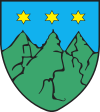Torzym
| Torzym | |||
|---|---|---|---|
|
Main square | |||
| |||
 Torzym | |||
| Coordinates: 52°18′46″N 15°4′40″E / 52.31278°N 15.07778°E | |||
| Country |
| ||
| Voivodeship | Lubusz | ||
| County | Sulęcin | ||
| Gmina | Torzym | ||
| Area | |||
| • Total | 9.11 km2 (3.52 sq mi) | ||
| Population (2006) | |||
| • Total | 2,456 | ||
| • Density | 270/km2 (700/sq mi) | ||
| Postal code | 66-235 | ||
| Website | http://www.torzym.pl | ||
Torzym [ˈtɔʐɨm] (German: Sternberg in der Neumark) is a town in Sulęcin County, Lubusz Voivodeship, in western Poland, with 2,466 inhabitants (2004). It is the administrative seat of the urban-rural Gmina Torzym. The town is located about 36 km (22 mi) east of the border with Germany at Słubice.
History
The fortress arose in the Lubusz Land, which had been sold by the Silesian duke Bolesław II the Bald of Legnica to Brandenburg and the Archbishopric of Magdeburg in 1248. It was located on the road to Poznań and probably named after Konrad von Sternberg, Archbishop of Magdeburg from 1266 until 1277. From 1287 the Ascanian margraves of Brandenburg were sole rulers of Lubusz, who from about 1300 called the whole area east of the Oder river Sternberger Land, the nucleus of the larger New March. The settlement received town privileges in 1375. The Sternberg Land was later recalled in the 1816-founded Sternberg district, in 1873 divided in two, a western and an eastern district, within the Frankfurt Region.
Heavily devastated during the Vistula–Oder Offensive of the Red Army in the last weeks of World War II (On 31 January 1945), the town fell to the Republic of Poland by the implementation of the Oder-Neisse line in 1945. It was initially renamed as "Toruń Lubuski", but was later changed as Torzym by Polish authorities. After 1945 the native German population was expelled and replaced with Poles.
External links
- Jewish Community in Torzym on Virtual Shtetl
Coordinates: 52°19′N 15°05′E / 52.317°N 15.083°E


